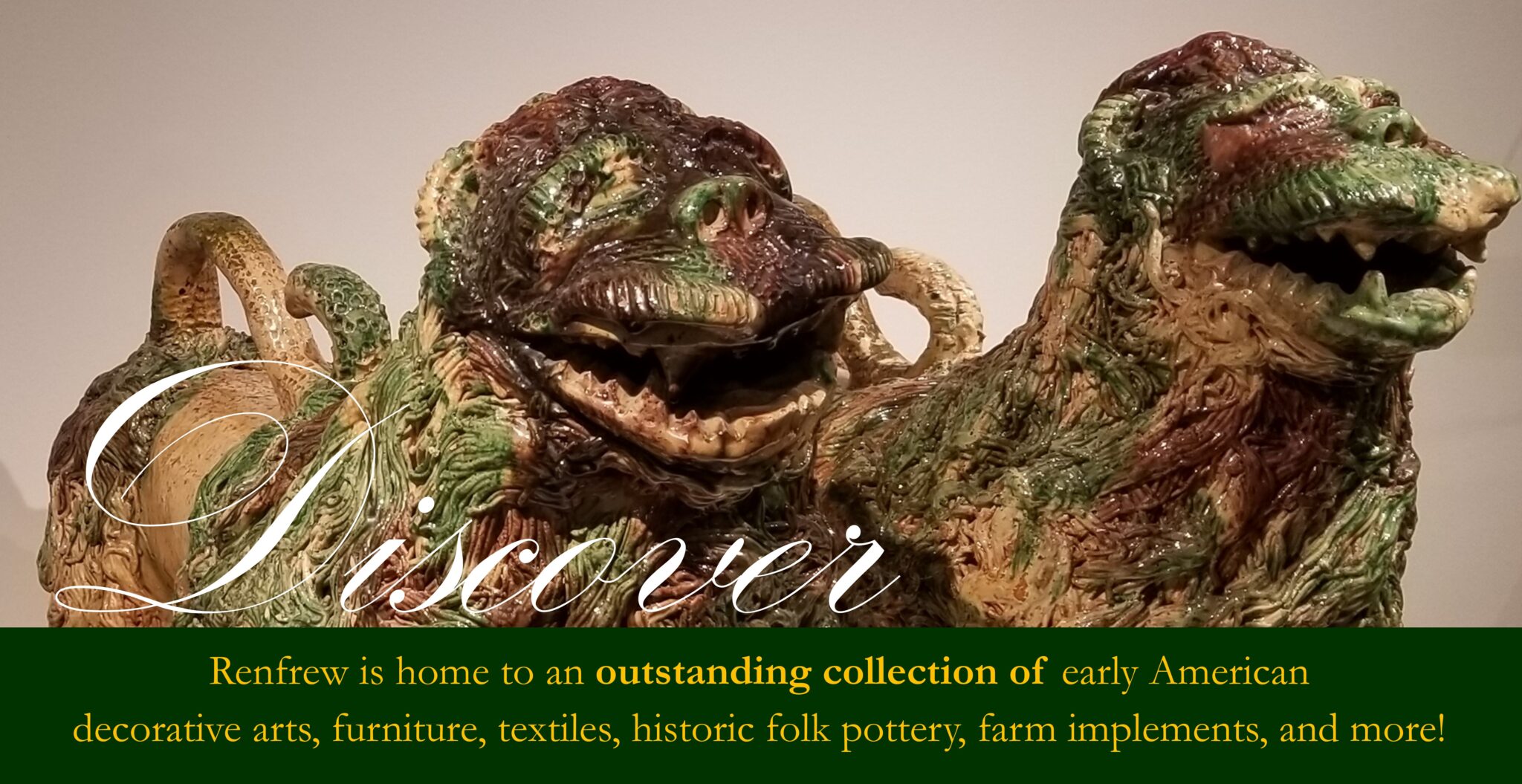
Early American Home Furnishings
Renfrew’s founder, Emma Geiser Nicodemus, filled her restored Federal Style stone farmhouse with a personally curated collection of early American decorative arts dating from the eighteenth and nineteenth centuries. Those who knew her best said she just collected what she liked. With no formal art history training or antiques expertise, Mrs. Nicodemus relied on her own good taste along with advice from close friends and fellow collectors to develop a keen eye for the historic and beautiful, hand-selecting pieces to furnish her period home. Her eclectic collection of antiques grew to include fine ceramics, folk art, silver, furniture, textiles, toys, books, and more. Today, Mrs. Nicodemus’ antiques form the core of Renfrew’s museum collection of nearly five thousand artifacts.
With special emphasis on decorative arts, domestic life, agriculture, and craft of the Early American Period (1790-1830), Renfrew Museum serves as a repository for artifacts that tell the story of our young nation’s growth from a local point of view. Highlights of Renfrew’s diverse holdings include a mixture Pennsylvania German dower chests, fraktur, chalkware, and scherinsnitte displayed alongside early English staffordshireware, Canton China, and Baltimore Federal Era Furniture. Included also are locally made tall case clocks by Waynesboro artisans Jacob Wolf and Peter Grumbine.
Bell Family Historic Folk Pottery
On exhibit in the Visitors Center is one of the largest displays of John Bell and family historic folk pottery of the Shenandoah and Cumberland Valley regions. Perhaps the most famous artisan of Waynesboro’s early history, John Bell (1800-1880) learned the German pottery tradition from his father Peter Bell of Hagerstown, Maryland. John Bell, along with his brothers Solomon and Samuel of Strasburg, Virginia, are among the best recognized nineteenth century folk potters of the Shenandoah and Cumberland Valleys.
In 1833 Bell opened his pottery in Waynesboro at his home on the corner of Main and Potomac Streets. On exhibit in Renfrew’s Visitors Center Gallery are over 300 pieces from both the Waynesboro and Strasburg potteries, along with other significant Cumberland Valley makers of the nineteenth century.
Locally-Made Pennsylvania-Kentucky Longrifles
On display in the main Visitors Center Gallery is an exhibit of nineteenth century longrifles, powder horns, and accoutrements of the Cumberland Valley.
“Kentucky Longrifles” were originally known as “Pennsylvania Longrifles” because they were created in Lancaster, Pennsylvania in the 1730’s by skilled immigrant craftsmen from Germany and Switzerland. The Pennsylvania Longrifle was designed to be light, slender and graceful – the first truly American firearm.
Renfrew’s small collection of Pennsylvania-Kentucky longrifles contains representative examples of regionally-produced longrifles from the nineteenth century. Works by Henry Carlile of Shippensburg, his apprentice and later master gunsmith John Johnston of Waynesboro, and Henry Noll of Washington Township.
Snow Hill Cloister Collections
(Gallery Currently Closed for Exhibit Work)
Nancy Royer (1812-1896), youngest daughter of Daniel and Catherine Royer and one of Renfrew’s longest residents, married Peter Fahnestock in 1847. The Fahnestocks were among the founding families of the Snow Hill Cloister in Quincy Township, Franklin County, Pennsylvania, an offshoot of Seventh Day Baptist society Ephrata Cloister. Following their marriage, Nancy and Peter were both active “householders”- married, working members of the Snow Hill Congregation. Along with working their farmstead at the southeastern end of the Renfrew property, the Fahnestocks maintained close ties to the the brothers and sisters living at Snow Hill.
Snow Hill Cloister ceased its operations in the twentieth century when the last of its celibate order passed away. Renfrew Museum has since acquired several cloister artifacts that went to auction through purchase and donation by others. These are on display in the Snow Hill Exhibit.
